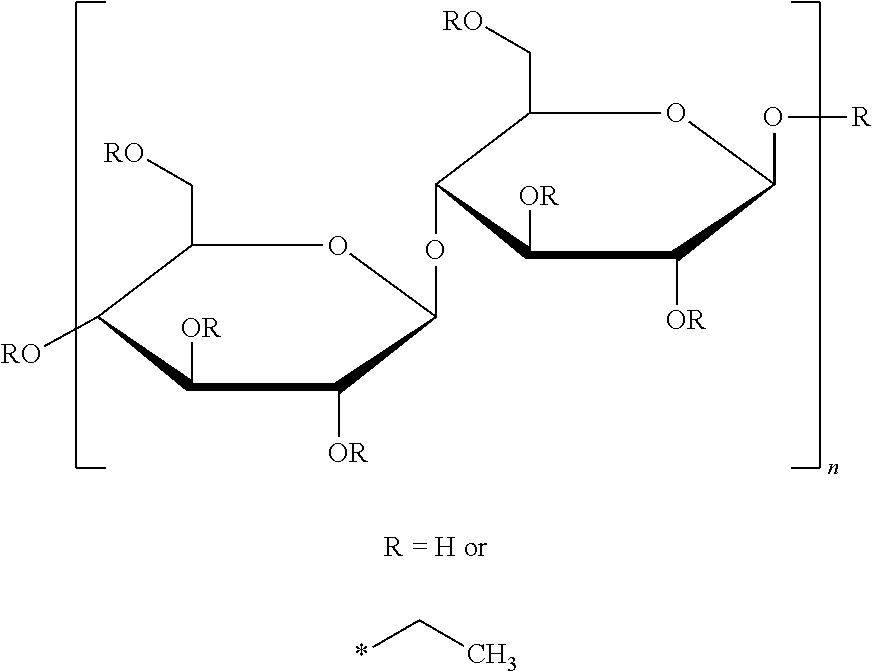Food product containing ethylcellulose
a technology of ethylcellulose and food products, applied in the field of food products, can solve the problems of insufficient scattering, and achieve the effects of improving scattering behaviour, good spattering performance, and low salt conten
- Summary
- Abstract
- Description
- Claims
- Application Information
AI Technical Summary
Benefits of technology
Problems solved by technology
Method used
Image
Examples
example 1
Preparation of Ethylcellulose Colloidal Particles in Dispersion Materials
[0070]Aqualon® Ethylcellulose (type N 100) in powdered form was purchased from Hercules (Widnes, UK) and used as received. Ethoxyl content was 48.0-49.5%, and degree of substitution was 2.46-2.57. Viscosity was 80-105 mPa.s (at 5% and 25° C. in 80 / 20 toluene / ethanol). Particle size is between about 100 and 500 micrometer. Acetone (analytical grade) and tartaric acid were obtained from Sigma-Aldrich Chemicals (Schnelldorf, Germany) and used without further purification. Deionised water was obtained from a Millipore filter system.
Particle Sizing / Electrophoresis
[0071]Dynamic light scattering measurements were carried out using a Zetasizer Nano ZS instrument (Malvern Instruments, Malvern, UK) to determine the average particle diameter. Samples were measured without any dilution at 25° C. The viscosity of water was assumed in all cases and a refractive index of 1.59 was used in the analysis. The results from the mea...
example 2
Oil-Continuous Emulsions Containing Ethylcellulose Particles
[0077]Commercially available Blue Band liquid margarine (ex Unilever, Rotterdam, The Netherlands) was used to determine the antispattering effect of ethylcellulose particles. This margarine is a water-in-oil emulsion, which is regularly used for shallow frying.
[0078]Ingredients of this Blue Band liquid margarine are (in weight % of the total composition): total vegetable oils and fats 82% (saturated ˜8%, monounsaturated ˜49%, polyunsaturated ˜24%), water, salt (NaCl) 1.5%, emulsifier (soy lecithin), flavours, citric acid, colourant (beta-carotene), vitamins A and D.
[0079]Ethylcellulose particles (both N 100 as received, as well as in 2 wt % colloidal dispersion as obtained in example 1) were manually dispersed in this emulsion, at various concentrations. The primary and secondary spattering values as determined are indicated in the following table.
TABLE 2Concentration of ethylcellulose particles and obtainedprimary and seco...
example 3
Water-Continuous Emulsions Containing Ethylcellulose Particles
[0089]Commercially available Becel keuken light liquid emulsion (ex Unilever, Rotterdam, The Netherlands) was used to determine the antispattering effect of ethylcellulose particles. This is an oil-in-water emulsion, which is regularly used for shallow frying.
[0090]Ingredients of this Becel light liquid emulsion are (in weight % of the total composition): total vegetable oils and fats 56% (saturated ˜6%, monounsaturated ˜21%, polyunsaturated ˜29%), water, salt (KCl) %, emulsifier (soy lecithin), thickeners (guar xanthan gum, guar gum), citric acid, potassium citrate, preservative (potassium sorbate), flavours, vitamins A, D and E, colourant (beta-carotene).
[0091]Ethylcellulose particles (both as received, as well as in 2 wt % colloidal dispersion as obtained in example 1) were manually dispersed in this emulsion, at various concentrations. The primary and secondary spattering values as determined are indicated in the foll...
PUM
 Login to View More
Login to View More Abstract
Description
Claims
Application Information
 Login to View More
Login to View More - R&D
- Intellectual Property
- Life Sciences
- Materials
- Tech Scout
- Unparalleled Data Quality
- Higher Quality Content
- 60% Fewer Hallucinations
Browse by: Latest US Patents, China's latest patents, Technical Efficacy Thesaurus, Application Domain, Technology Topic, Popular Technical Reports.
© 2025 PatSnap. All rights reserved.Legal|Privacy policy|Modern Slavery Act Transparency Statement|Sitemap|About US| Contact US: help@patsnap.com

